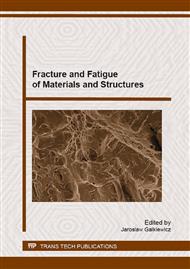[1]
R.T. Cundill, Rolling element bearings into 21st century, IMechE, Seminar, London, November, (1990).
Google Scholar
[2]
Y. Wang, M. Hadfield, The influence of ring crack location on the rolling contact fatigue failure of lubricated silicon nitride: experimental studies, Wear 243 (2000), 157-166.
DOI: 10.1016/s0043-1648(00)00435-x
Google Scholar
[3]
W. Karaszewski, The influence of oil additives on spread cracks in silicon nitride, Tribology International, vol. 41, issue 9-10 (2008) 889-895.
DOI: 10.1016/j.triboint.2007.12.002
Google Scholar
[4]
Karaszewski W.: Crack propagation in zirconia MgO-PSZ ceramic materials. Key Engineering Materials, Vol. 490 (2012) 54-63.
DOI: 10.4028/www.scientific.net/kem.490.54
Google Scholar
[5]
Y. Wang, M. Hadfield, Failure modes of ceramic rolling elements with surface crack defects. Wear 256 (2004) 208-219.
DOI: 10.1016/s0043-1648(03)00409-5
Google Scholar
[6]
W. Karaszewski, Surface cracks of ceramic rolling elements, Acta Mechanica et Automatica, vol. 3, no 1(7) (2009) 68-70.
Google Scholar
[7]
C. Cirel, T.A. Stolarski, Factors affecting the wear of ceramic balls, Wear 172 (1994) 191-196.
DOI: 10.1016/0043-1648(94)90287-9
Google Scholar
[8]
Y. Wang, M. Hadfield, The influence influence of ring crack location on the rolling contact fatigue failure of lubricated silicon nitride: fracture mechanics analysis, Wear 243 (2000), 167-174.
DOI: 10.1016/s0043-1648(00)00436-1
Google Scholar
[9]
M. Hadfield, T.A. Stolarski, R.T. Cundill, S. Horton, Failure modes of ceramic elements with ring crack defects, Tribology International 26 (1993) 157-164.
DOI: 10.1016/0301-679x(93)90089-j
Google Scholar
[10]
W. Karaszewski, Research on the effects of selected factors on the life of ceramic rolling bearing elements, Gdansk University of Technology, monograph, (2013).
Google Scholar
[11]
Akama M., Mori T.: Boundary element analysis of surface initiated rolling contact fatigue cracks in wheel/rail contact systems. Wear, Vol. 253 (2002) 35-41.
DOI: 10.1016/s0043-1648(02)00080-7
Google Scholar
[12]
Bogdanski S., Lewicki P., Szymaniak M.: Experimental and theoretical investigation of the phenomenon of filling the RCF crack with liquid, Wear, Vol. 258 (2005) 1280-1287.
DOI: 10.1016/j.wear.2004.03.038
Google Scholar
[13]
Bower A. F.: The influence of cracks face friction and trapped fluid on surface initiated rolling-contact fatigue cracks. Journal of Tribology Transaction, Vol. 110 (1998) 704-711.
DOI: 10.1115/1.3261717
Google Scholar
[14]
Karaszewski W.: Numerical analysis of crack propagation in silicon nitride. Key Engineering Materials, Vol. 490 (2012) 216-225.
DOI: 10.4028/www.scientific.net/kem.490.216
Google Scholar


